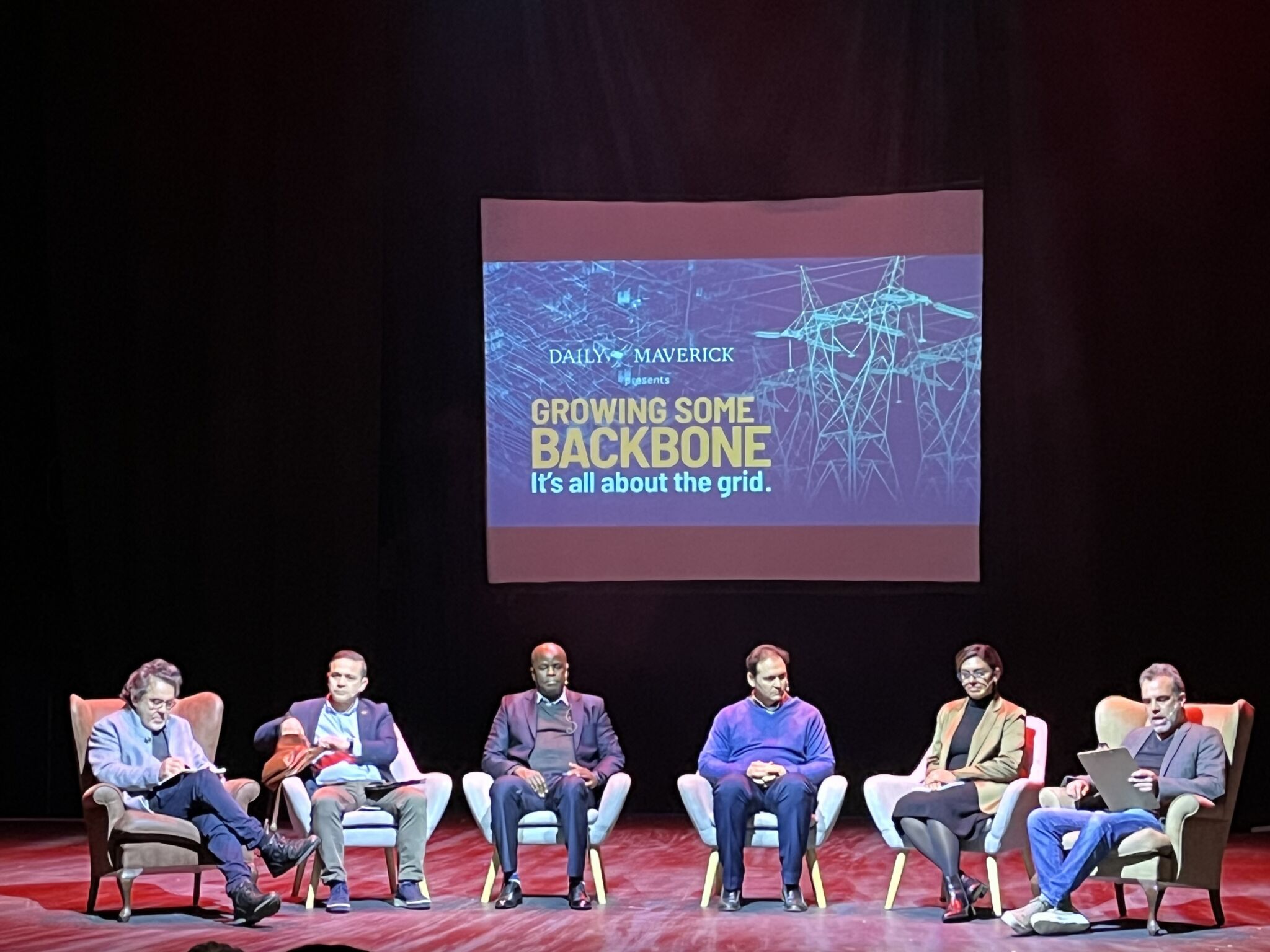A reflective piece from the live debate: Growing the backbone – it’s all about the grid

The event took place at the Star Theatre, at the District Six Museum’s Homecoming Centre, in Cape Town.
“As we saw in the latest renewables bidding window… we have way more gigawatts of wind and solar power waiting to come online than the grid can currently handle.” These impactful words, said by Daily Maverick’s Kevin Bloom, marked the commencement of the debate, “Growing Some Backbone – It’s all about the Grid”.
These words paint a sobering picture for millions of South Africans who have had to endure Stage 6 loadshedding in recent months. Our inability to connect this much-needed electrical capacity is due to the grid infrastructure’s very limited capacity. Distinguished Professor Mark Swilling from the Centre for Sustainability Transitions (CST) at Stellenbosch University, and second co-host for the debate, described the grid as the “Cinderella” of the national energy system, previously overlooked and underappreciated. However, on the evening of 28 June 2023, at the Homecoming Centre in District Six, Cape Town, Cinderella finally got her night.

Mark Swilling, Kashif Wicomb, Mohale Rakgate, Ronald Marais, Chantal Naidoo and Kevin Bloom participate in a debate on grid expansion.
The panel consisted of four distinguished experts in the energy sector: Mr Ronald Marais, Strategic Grid Planning Manager at Eskom; Dr Chantal Naidoo, Executive Director and Founder of Rabia Transitions Initiatives; Mr Mohale Rakgate, Chief Investment Officer of the Infrastructure Fund; and Mr Kashif Wicomb, Chief Executive Officer of Adenco Construction.
The foundation of the evening’s dialogue can be traced back to the consultation paper entitled “Better Finance, Better Grid”, produced by the CST and the Blended Finance Taskforce, along with the recommendations report released by the Presidential Climate Commission (PCC). This remarkable convergence of viewpoints was made possible thanks to funding from the United Nations Development Programme, with plans for similar events to be held in the future.
The discussion commenced with the role of finance, shedding light on the funding needs outlined in the Just Energy Transition Investment Plan (JET IP) and the climate finance agreement formulated by the team led by Mr Daniel Mminele, who at the time, was the Head of the Presidential Climate Finance Task Team. According to the JET IP, South Africa requires an estimated R1.5 trillion in the next five years to facilitate the just energy transition process.
Dr Naidoo, who formed part of both these teams, remarked that the figure of R1.5 trillion had a strategic rationale behind it, emphasising that the portion allocated to the grid was relatively small compared to the overall grid investment required globally. She highlighted the importance of South Africa’s robust and innovative financial sector in providing the majority of this funding. Dr Naidoo emphasised that climate finance is centered on justice and equity, but achieving this would require the correct sequencing, with the grid being the next and most urgent item in that sequence. “The grid is effectively the backbone of the country’s justice agenda because if we do not have a strong grid, everything else falls apart,” she said.
Mr Marais echoed these sentiments, placing emphasis on the urgency of implementing solutions now. He noted the need to swiftly add more generation to the grid and optimise the existing grid. As a result, Eskom has collaborated with renewable associations to conduct a survey to track the progress of projects by various developers. Many of these projects are situated in areas that are already congested, prompting the promotion of congestion management systems, such as curtailment, to unlock the untapped potential of this “ready” generating capacity.
He also emphasised the importance of establishing a more comprehensive tariff system that acknowledges the diverse services offered by the grid to ensure the system is appropriately compensated. These mechanisms and reforms should be implemented while simultaneously expediting the construction process. In this regard, he clarified that it is not Eskom that constructs or supplies materials for the grid. The responsibility for scaling up grid extension and enhancement lies with the private sector.
Mr Wicomb further expanded on this viewpoint, shedding light on the obstacles confronted by engineering, procurement, and construction (EPC) companies and contractors who would need to take on the massive task of constructing the grid infrastructure. He began by quantifying the immense undertaking that lies ahead — constructing 14 200 kilometers of transmission lines and installing
122 000MWA transformers within the next decade. This task is by no means insignificant, considering that it is more than six times the scale of the previous decade’s construction efforts. When asked what it would take to accelerate the build to South Africa’s needs, he listed the following key challenges in the sector:
- Insufficient technical capacity and workforce. South Africa faces a shortage of accredited engineers capable of undertaking the required work. Many engineers are employed by engineering consultancies or international renewable energy companies that offer higher salaries compared to those in South Africa.
- Insufficient guarantee facilities. Local contractors are unable to provide the guarantees that project developers require, which will massively affect big projects that the grid extension requires. There is therefore a need for developmental financial institutions to step in more aggressively to provide guaranteed facilities that contractors need. The alternative is that international contractors, who have sufficient resources, come in and build, but this will likely result in limited economic development.
- Lack of market certainty. Contractors need certainty regarding upcoming projects for at least a two-year period to justify investing in the costly materials, equipment, and expertise necessary for these projects.
- Lack of technical skills development in the country. Less than 1% of the high schools in South Africa are technical high schools. To build long-term capacity, there is a need for more technical high schools. In the short term, experienced engineers should be called to mentor younger engineers to increase capacity to tackle the challenge ahead.
In thinking about these challenges in the context of the wider just energy transition, this conversation could not take place without addressing the contentious matter of private sector participation and the potential risk of privatising a resource that is intended to serve as a public good.
Mohale Rakgate addressed this issue by highlighting the learning opportunities derived from the Independent Power Producer (IPP) Office and examining international instances of public/private partnerships. He emphasised that, when properly utilised, the private sector could do a lot of developmentally heavy weightlifting that the state has limited capacity to do. Concessional funding and the build-operate-transfer (BOT) model were discussed as potential solutions for expanding the grid infrastructure. However, Mr Mohale stressed the importance of enhancing the government’s ability to design and manage public/private partnership programmes in a manner that ensures contractual balance, transparency, and enables effective monitoring of concessioners’ performance and obligations.
The lively discourse was a relevant one in light of the country’s energy crisis. The discussion was concluded on an optimistic note by referencing a visionary perspective of the future through an excerpt of an op-ed, “Growing some backbone – reimagining the future of Eskom and the grid” by Prof Swilling. The perspective envisions a South Africa where loadshedding is a memory and hundreds of publicly, municipally, socially and privately owned electricity generators have proliferated across the nation.
* This reflective piece was written by Alboricah Rathupetsane, a Junior Researcher at the Centre for Sustainability Transitions
Watch the full recording of the live debate below.